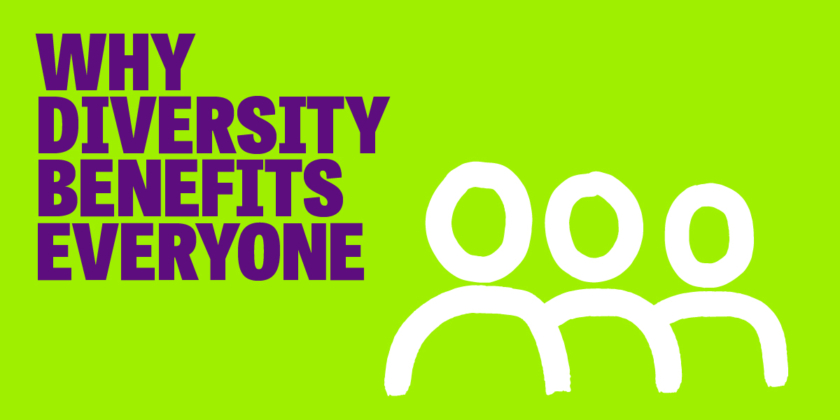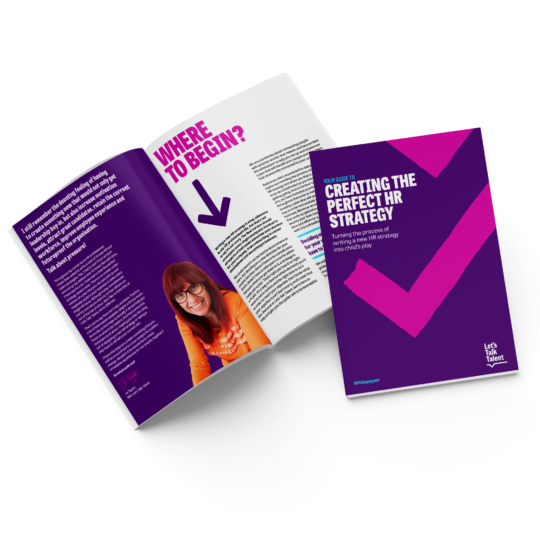The benefits of a diverse workforce in the UK
In our blog Why You Don’t Need The Best People, we shared with you our guide on how to build better teams and get the best from your people, outlining how equality, diversity and inclusion (ED&I) is a vital part of this. However, this topic requires a special focus and consideration due to its undeniable importance, and the benefits that are born out of having a more diverse organisation.
Why equality, diversity and inclusion (ED&I) matters
ED&I not only benefits individuals and groups that have previously been marginalised and underrepresented, but everyone in the organisation.
When we cultivate a more accepting attitude towards others, we can dismantle stereotypes and barriers, which are detrimental to both the individuals subject to them and the people who are acting upon biases and being discriminatory.
When we cultivate a more accepting attitude towards others, we can dismantle stereotypes and barriers, which are detrimental to both the individuals subject to them and the people who are acting upon biases and being discriminatory. In minimising the opportunities of success for individuals belonging to minority groups, we are stopping our organisations from reaching their full potential.
Here are some reasons why you should be actively seeking diversity in your organisation:
The benefits of diversity and inclusion in the workplace
Defined as “the description or portrayal of someone or something in a particular way,” representation can affect how we feel about our own ability to achieve something. Visibility of someone that you can relate to throughout the organisation, particularly at board level, gives reassurance that you too are able to progress and achieve. The impact of marginalised individuals seeing themselves represented in top-level positions can subtly, or overtly, fuel their drive and motivation to dissolve barriers and stop stereotypes becoming self-fulling prophecies. Representation sends the message that success is not exclusive to one specific type of individual. Every person in an organisation should be able to look up to the top and think, “Hey, that could be me!” and this is the exact type of motivation you need to have a productive workforce.
When devising your diversity programme, don’t forget to consider neurodiversity as a key factor. Listen to some practical tips from neurodiversity champion Mel Francis on our podcast.
ED&I as a tool for innovation and high-performance
Bringing together individuals from a wealth of diverse backgrounds will certainly improve your organisation’s idea generation and problem solving.
When you combine diversity of expertise with social diversity, it makes for diversity of information, leading to the unearthing of new approaches and methods that otherwise may have gone undiscovered. The ideas generated will become more varied and cultured, helping to avoid the dreaded group think.
New perspectives can stimulate creative thinking, leading to stronger problem-solving, and nuanced decision-making: the perfect recipe for innovation.
Research also shows that: “Diversity in decision-making equates to profitability in the global economy”. A Forbes article shows that companies with a diverse workforce are 70% more likely to capture new markets. This demonstrates that diversity is a competitive differentiator, shifting market share towards more diverse companies.
How to build a high-performance diverse team at work
Blind hiring as a recruitment tool
When it comes to recruitment, removing basic information such as the applicant’s name and date of birth from their CV’s and application forms brings more focus to their experience and qualifications, and limits the ability for recruiters to act upon unconscious biases.
Others go a step further and remove even more personal details such as an applicant’s education, as subconscious biases can sometimes see recruiters hiring candidates with a similar education to their own. The CIPD’s Head of Research, Ksenia Zheltoukhova, said: “Anonymising CVs is an effective intervention for increasing diversity in organisations and reducing bias in recruitment.” Listen to the full podcast on unconscious bias here.
If you’re looking to use blind hiring in your organisation but don’t know where to start, Applied offer a service that features gendered language detection which can spot and remove any gendered language from your job descriptions and questions, Bias-free review processes; anonymising applications and sharing them across independent reviewers to remove bias, Readability scoring on job description to craft open and inclusive job descriptions, and Diversity monitoring so you can see real time data on the diversity performance of your roles, including the pipeline.
Age diversity as a key recruitment factor
Equally appreciating both these criteria and understanding the value of having a mixed age organisation will help you to create a happier and more diverse workforce. And HR Zone article reported that organisations with a diverse age range of people working together showed “(…) employees were up to 10% happier in their jobs and had a more positive outlook towards their employer.”
Flexible working to accommodate a diverse workforce
By being flexible with work practices and arrangements, you permit employees more choice in deciding how they will accomplish the work you hired them to do. This makes it easier for them to take care of their family or follow their passions outside of the workplace, which in turn can increase their productivity; as an employee who feels fulfilled both professionally and personally is more likely to be engaged and productive. In this Guardian article, Natalie Pancheri, HR Policy Adviser at the London School of Economics, says that when you embed a culture of flexibility, it can reduce the types of issues that can prevent women from advancing their careers, and men from spending time with their family, as well as ensuring that this becomes the norm rather than ‘special treatment’ that may conjure a feeling of resentment in others.A great way to ensure employees stay connected in a flexible working environment is to use technology to bring all your communications together. Use messaging tools and file sharing platforms to facilitate collaboration.
Empowering diverse teams to resolve conflict
In diverse teams, conflict is expected. The best way to deal with these situations is to give teams the tools they need to resolve the issues themselves. You can do this by providing teams with conflict training, educating them on conflict styles and resolution. When you educate teams on conflict styles, they can learn to identify their own and better understand each other’s, and work on developing these to be more effective.
Using tools and workshops from sites such as Mindtools or WorkshopBank is a great way to educate employees on how to resolve team conflict and build stronger teams by facing their differences.
Mentoring new and high-potential employees
Fostering talent early is vital to ensure marginalised and minority individuals know how to make the best decisions to get them where they want to be in their career.
Formal mentoring programmes can assist your organisation to excel in ED&I management, by identifying and nurturing high-potential employees. This mentoring can help to develop a pool of future leaders that is representative of the diverse cultures, identities, races, ages, ethnicities, backgrounds and beliefs of your organisation. This collection of future leaders can then influence and develop processes and programmes that boost employee engagement and loyalty.
Mentoring can particularly help people who are in the minority, or at more junior grades, to have greater influence, and to progress their careers.
ED&I as a culture change
Although there are advancements being made in workplace diversity which should be celebrated, it remains a deeply ingrained, ongoing issue that will not cease to exist overnight.
Changing the make-up of your workforce and fostering diversity requires a clear and consistent focus, full support and buy-in throughout the organisation, particularly at board level. Most importantly, the efforts need to be committed and consistent.
For some expert guidance on how to promote diversity within your organisation and improve your internal culture, don’t hesitate to book a call with us.
Alternatively, check out the culture audit page of our website for free, downloadable resources including our HR Strategy whitepaper.
And when devising your yearly HR strategy, don’t forget that ED&I is only one of the trends HR directors need to know about in 2023. Have a look at the article for the full list of UK HR Statistics in 2023.

